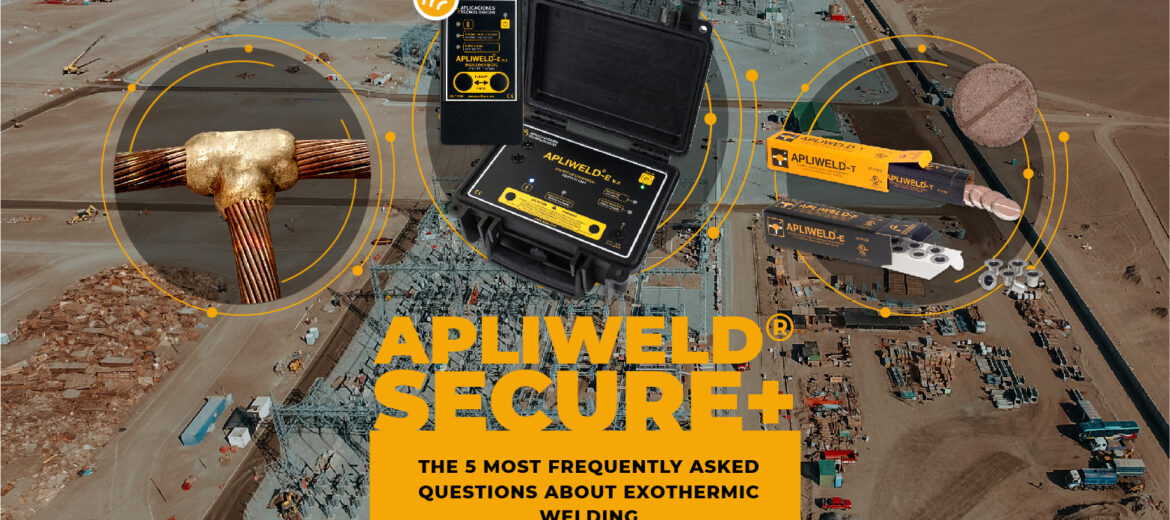Exothermic or aluminothermic welding is the chemical process that allows two or more conductors to be joined together in a durable manner. It is mainly used in earthing systems due to its reliability, resistance and a series of advantages over other types of joints. Knowing whether it is properly carried out, how to calculate the necessary material or how to guarantee the safety of people in the event of a chemical reaction are the main questions answered by Aplicaciones Tecnológicas.
The installation of earthing grids is one of the fundamental steps in the early stages of the construction of any infrastructure. A good welding system will make all the difference to the durability of the installation. Exothermic welding, also known as aluminothermic welding, provides permanent, reliable and highly conductive joints.
Exothermic welding achieves molecular bonding between conductors made of copper, stainless steel, galvanised, bronze, etc. The basis of the process is an exothermic chemical reaction in which the aluminium reduces the copper oxide producing the copper that totally or partially melts the conductors to be welded, providing a superior connection to any mechanical joint (more susceptible to wear and corrosion), with respect to both mechanical and electrical properties.
To find out more about the particularities and advantages of this type of joint, these are the questions most frequently asked by Aplicaciones Tecnológicas specialists about exothermic welding.
- How can I tell if welding is well done?
The way to know if a weld has been made correctly is by visual inspection. To do this, a copper-coloured solder should be observed, which may vary in intensity, but which has a metallic shine and is free of slag and pores that affect the connection. The volume, once solidified, should cover at least the previous dimensions of the conductors to be welded.
- What happens in the welding process?
In the welding process, a chemical reaction takes place, the main product of which is molten copper. This copper reaches the conductors and melts them, so that when it solidifies it forms a new compound with the properties of the reaction copper and the conductor itself; also copper, in most cases.
Reaction copper is very pure and the solid formed is thicker than the conductor, so the electrical properties are equal to or better than those of the conductor itself, which affects its durability and wear resistance.
- How can I find out what material is needed for an exothermic welding required for an installation?
In order to carry out a welding project, it is necessary to know which connections need to be made, which conductors are going to be used and the quantity of each of these connections required. Once this information is known, which is generally reflected in the project specifications, a calculation is made to estimate the amount of material required for a specific installation. For this task, Aplicaciones Tecnológicas has its own tool, Apliweld® Secure+ Selector.
- What is a Prevention Technical Note?
The Prevention Technical Notes are the consultation material for professionals in occupational hazards approved by the National Institute of Occupational Health and Safety. Depending on the type of note, they advise and mark how to proceed in a safe and recommendable manner in sectors of industrial activity, in premises and installations, work equipment, etc.
NTP1028 (Safety in copper aluminothermic welding) provides information on the best and safest way to carry out the welding process, as well as the necessary preventive and protective measures to ensure the safety of the worker performing this task.
- What makes Apliweld® Secure + welding different from any other type of welding?
The main differences lie in the safety of the user in the ignition process and the versatility it offers.
Safety is achieved by the possibility of remote ignition, either by cable or by remote connection. During welding, molten copper is produced at more than 1100°C and sparks and material projections at very high temperatures are common. Electronic ignition at a distance of 1.5 metres if using the connection cable or up to 5-6 metres if via bluetooth connection and ensures that the user can never be hit by material spatter, sparks or any other element of the reaction. Electronic ignition also eliminates the use of flammable reagents and ensures a unique and safe procedure for such connections.
Versatility is provided by the format of Apliweld® welding tablets, which can be used for traditional ignition or the electronic ignition mentioned above. The replacement of the usual eight references by a single reference and its compact format makes it much more economical and easier to use and store. The existence of a single reference in tablets, with the number of tablets required for the connection and the possibility of using these same tablets with traditional or electronic ignition is another feature that helps to understand the flexibility of the system.
Apliweld® Secure Selector – Simplifying Exothermic Welding Earthing Projects
The Apliweld® Secure+ system developed by Aplicaciones Tecnológicas focuses on the efficiency and durability of the joints, its innovative tablet format and the safety of the worker who makes the joint.
In addition, the system has its own software for calculating exothermic welding earthing grid projects. By entering a series of parameters (connections, conductors and quantity) it calculates how many moulds, tablets, ignition material and accessories are necessary for a specific installation or project. The program returns the references and quantities required, so that the final material to be purchased can be known.
Aplicaciones Tecnológicas also has a reference selector on its website to find out about moulds, loads and accessories according to the type of joint.
If you want to know more about exothermic welding, you can contact us at this link.
